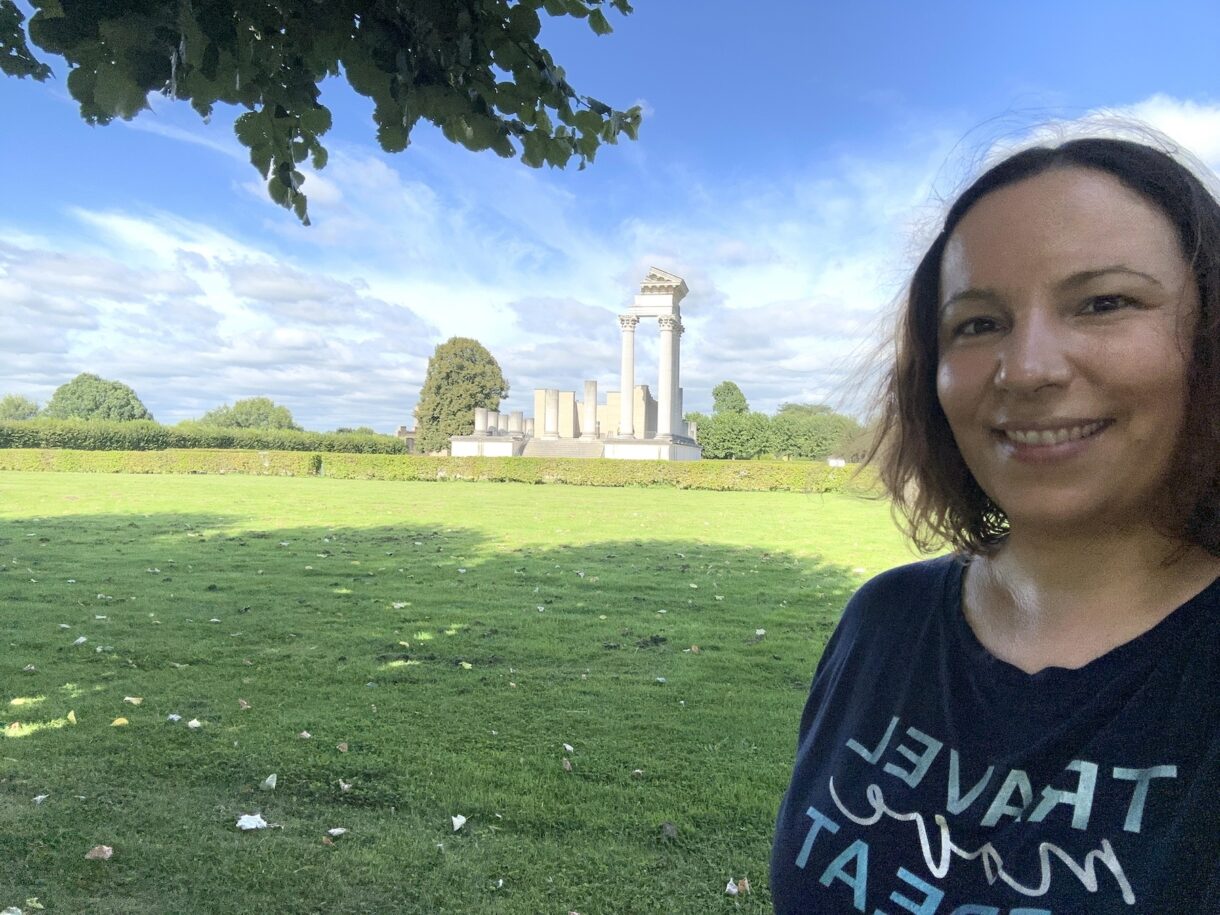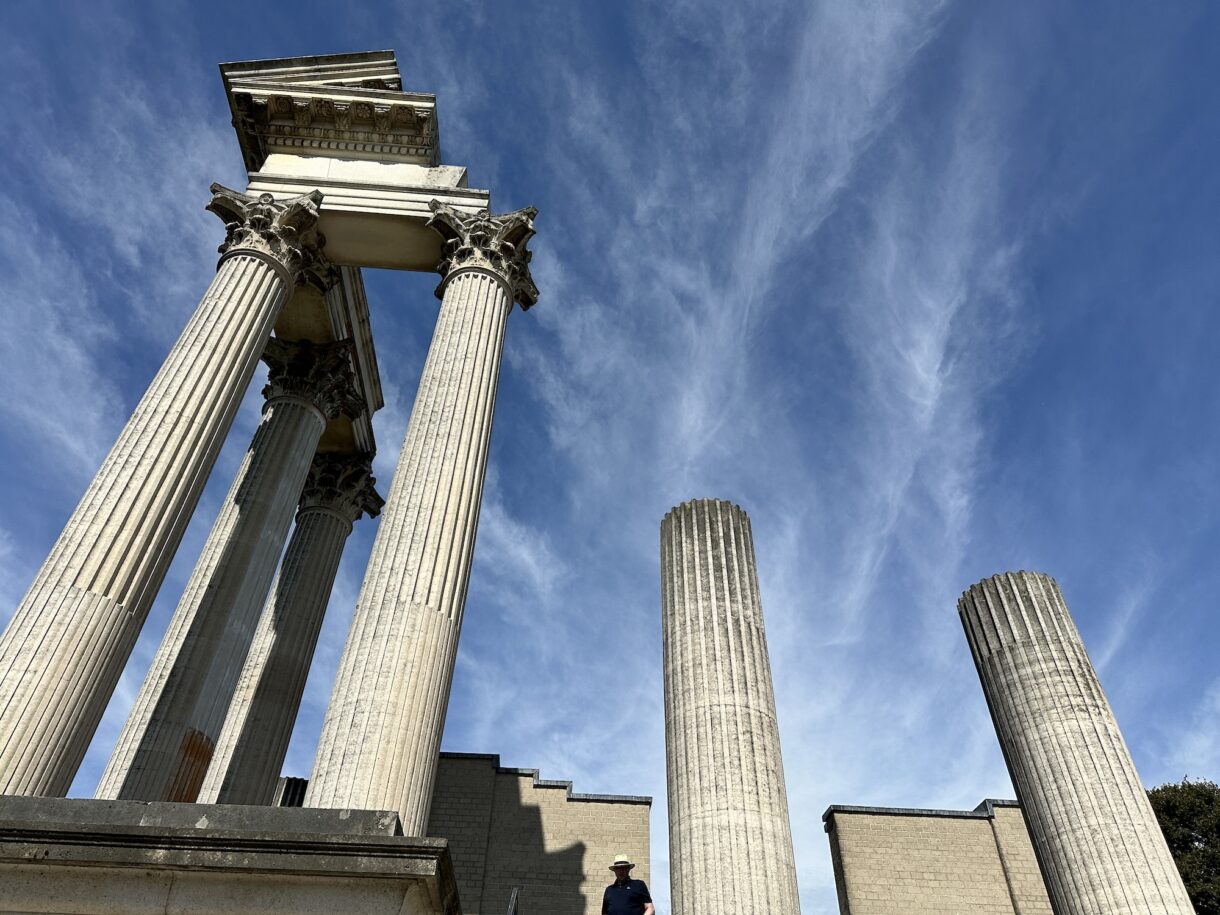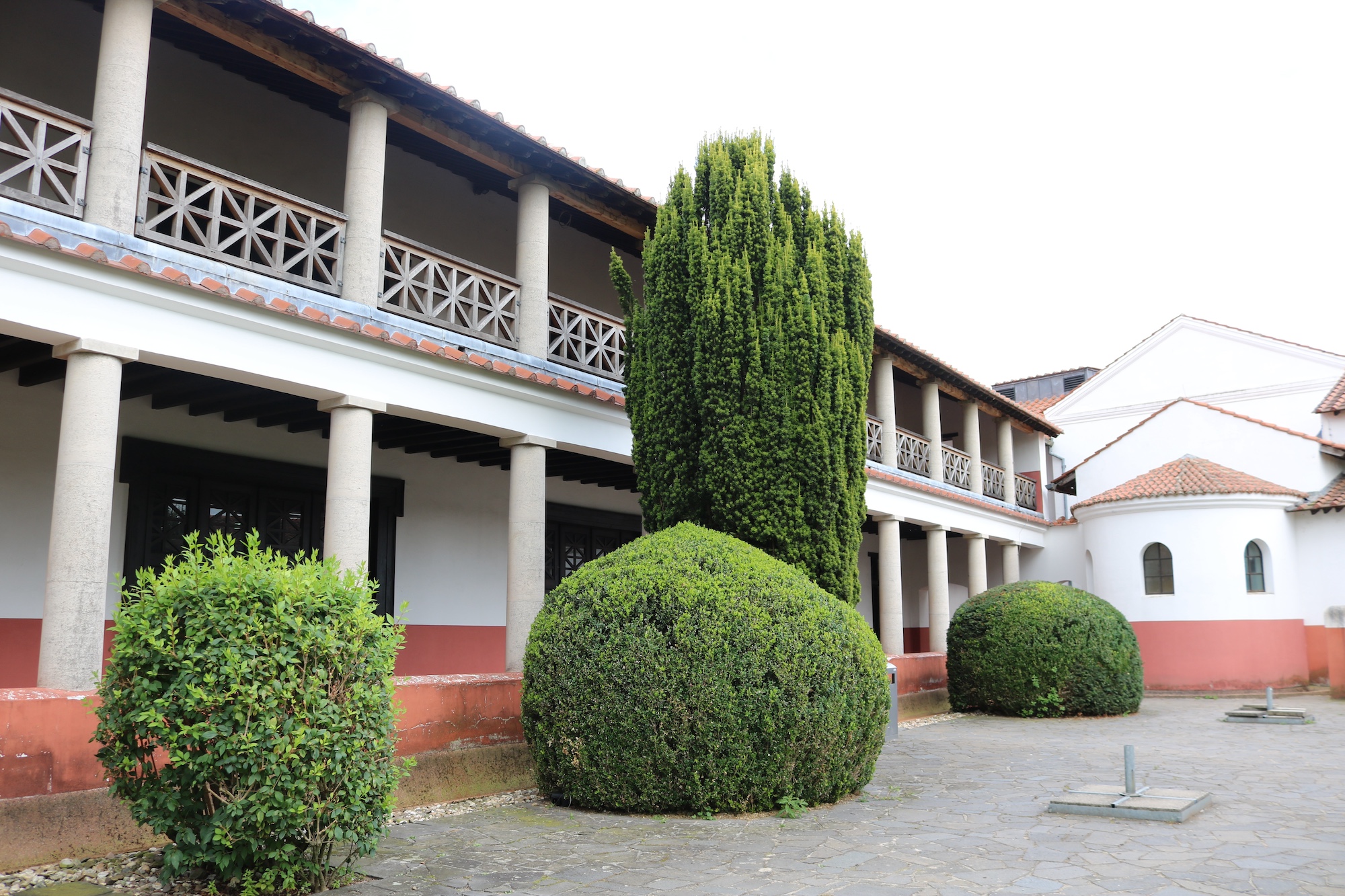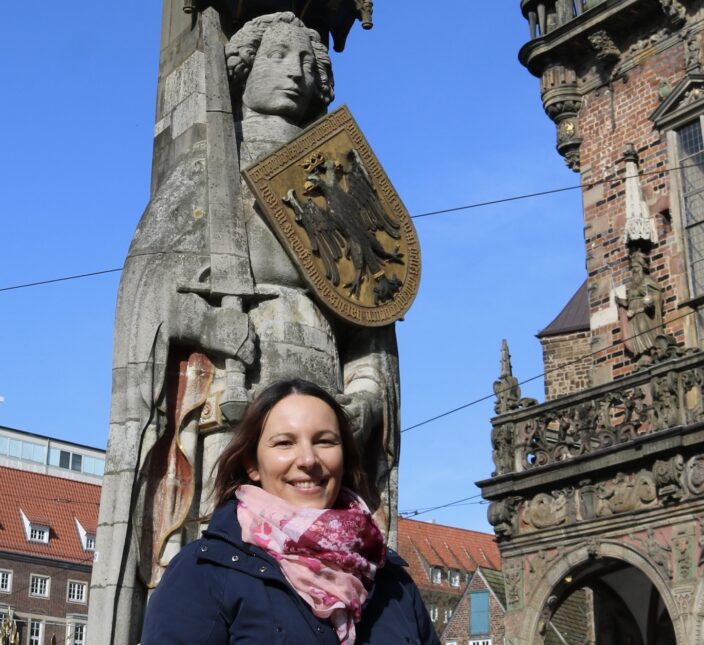Xanten in North Rhine-Westphalia is not only worth a visit when you have German ancestors from this area. At the archaeological open-air museum in Xanten, you can travel back in time an astonishing 2,000 years. Step into the time machine with me and let’s explore “Colonia Ulpia Traiana” – an ancient Roman city right in the middle of Germany.
What is the LVR-Archaeological Park Xanten?
Located on the site of a former Roman city, the open-air museum LVR-Archaeological Park Xanten (Landschaftsverband Rheinland Archäologischer Park or “APX” in short) offers a vivid insight into what life in Germany was like when the Romans were here – around 2,000 years ago.
The archaeological park and open-air museum is located very close to the town of Xanten (about 21,500 inhabitants) in North Rhine-Westphalia.
Towns nearby Xanten include Wesel, Kleve and Birten (the latter is nowadays a part of Xanten politically). So if your German ancestors are from here, you might visit the area anyway and should not miss a visit to the park!
Since July 2021, the archaeological park Xanten is also part of an area that has been declared a UNESCO World Heritage Site! The border to the Netherlands is also not far from here.

The Romans in Germany (a brief history)
The Roman Empire was one of the largest empires the world has ever seen and existed from around 27 BC to 476 AD.
From the late 1st century BC, Emperor Augustus (27 BC – 14 AD) and his fellow ambitious Romans set their sights on conquering Germania – the area which later would become Germany.
However, their encounters with the Germanic tribes, which the Romans often called “the wild Barbarians”, were not without its challenges.

No entry to (northern) Germania!
In the year 9 AD, the infamous “Battle of the Teutoburg Forest” (also known as the “Varus Battle”) took place. It is known from the archeological findings that parts of the battle (or even the most decisive battle) probably took place in Kalkriese near Osnabrück in northwest Germany (near my hometown Ankum actually).
Here, the Roman army faced a devastating defeat against the Germanic tribes led by the Germanic chieftain Arminius (around 17 BC – 21 AD) as they were lured into a trap in the dark forests of Germania.
After this decisive battle, the Romans retreated to areas in what is now middle and southern Germany and never made any more attempts to conquer areas in the north again. They even built a large wall fortification, known as the “Limes”.

Roman cities in Germany
In mid- and southern Germany, the Romans did establish several large cities in Germania – and with it the “Roman way of life”. This included an infrastructure and luxuries that the “Barbarians” in the north could only dream of. For example, “underfloor heating”, Roman baths and drainage systems.
Among the German cities established by the Romans is Trier on the Moselle River. Founded in 16 BC as “Augusta Treverorum”, Trier is said to be Germany’s oldest city.

Another famous Roman colony is modern-day Köln (or “Cologne” in English). Located on the Rhine, Germany’s fourth largest city today was founded as the Roman settlement “Colonia Claudia Ara Agrippinensium” in 50 AD.

The former town of Colonia Ulpia Traiana
The LVR-Archaeological Park Xanten is located on the same spot as the former Roman town “Colonia Ulpia Traiana”. For around 400 years, this city was one of the most important (and biggest!) Roman cities in Germania and even among the 150 highest-ranking cities in the entire Roman Empire.

The rise and fall of Colonia Ulpia Traiana
The colony on the Lower Rhine was founded by Roman Emperor Trajan (53 AD – 117 AD) around 100 AD and soon attracted immigrants from all over the Roman Empire to settle here.
Around 10,000 men, women and children lived in this buzzing Roman city during its heyday in the 2nd century AD. Remember this was huge at the time. Most Germanic tribes lived in very small settlements of just a few families or perhaps a few hundred people at the most.
But when the European mass migrations of various Germanic tribes started in the 3rd century AD, the Roman Colonia was increasingly threatened and eventually destroyed by the Germanic tribe of the Franks (or “Franken” in German).

The medieval town of Xanten
The Franks settled outside the old Roman city in individual farmsteads and small villages. In the following centuries, people often took stones from the Roman ruins and used them to build the medieval town of Xanten.
The area of the former Roman city remained uninhabited. Luckily for the archeologists today, because this way the old Roman city could be re-erected at its original location.

What’s there to see and do at the LVR-Archaeological Park Xanten?
If you visit the Xanten’s archaeological park today, you can literally set foot in Roman times and explore impressive reconstructions. Among them are a Roman amphitheater, the harbor temple and residential buildings.
The archaeological park Xanten is also an active excavation site and you can often see archeologists at work here. This also means that in years to come there will probably be even more Roman buildings to explore.
When walking along in the park, I was impressed by the straight paths that follow the ancient Roman street grid. These days, the paths are lined by trees. But in Roman times, the sidewalks were even covered by roofs! Amazing when you think about it.

1. The Harbor Temple
The first stop on our little virtual tour through the archaeological park Xanten is the partly re-constructed harbor temple. This temple was the second largest temple in the former Roman city after the Capitol.

Although the harbor temple was only partly reconstructed (there are just a few columns), I could still feel the former grandeur when I stood in front of it.
Originally, there was a statue of a god or goddess inside the cult room at the top. But it is still not known what god or goddess that was. Therefore, the temple was named after its location near the old river harbor.

2. The City Walls and Gates
These fortifications once protected Colonia Ulpia Traiana from external threats.
Here, you can climb up one of the city gates and enjoy a beautiful view over the park area and the Lower Rhine landscape.

3. The Roman Hostel and Roman Baths
In the fully reconstructed Roman hostel or inn for overnight guests, you can step into Roman bedrooms, living rooms, a working kitchen, and an underground pantry.

The hostel’s bathhouse is particularly impressive with its original-sized pools and colorful wall paintings.

4. The Craftsmen’s Houses
Three craftsmen’s houses showcase how ordinary people lived and worked in the Roman city.

What I found really cool was that you could literally step into a Roman house, walk upstairs and have a look at the town from a Roman balcony. That’s something I haven’t even be able to do in Italy (for example at Pompeji).

5. The Amphitheater
Step into a real Roman amphitheater, where gladiator fights and other spectacles once entertained the crowds.

In the exhibition inside the side entrances of the amphitheater, you can learn more about the (sometimes bloody) spectacles that used to happen here.

This is where the gladiators and animals would prepare and get ready for their fights in the arena.

6. The Roman Shipyard
One of the newer attractions at Xanten archaeological park is the shipyard, which showcases authentic replicas of Roman vessels and how these are constructed.
Among them are an ancient flat-bottomed ship, two fishing boats and a mighty sailing ship representing the thousands of Roman ships that once sailed on the Rhine.

7. The Roman Museum
If you have the time, definitely check out the indoor museum, called the LVR-RömerMuseum, within the park.

The museum’s exhibits delve deeper into the daily life in Roman settlements, show many interesting artifacts, and provide historical context.

There are also ruins of impressive bathing rooms inside the museum as well as video animations of what daily life might have looked like in the ancient Roman town here.

How to visit the LVR-Archaeological Park in Xanten
Getting your tickets
You can purchase your tickets for the Xanten archaeological park online from the park’s website or in-person at any of the three park entrances.

Getting there
If you come by (rental) car, there are plenty of parking spots available at the three entrances of the park. These are free for visitors of the archaeological park Xanten.
You will find detailed instructions on how to drive to the park on the park’s website.
Xanten can also be easily reached by public transport (train and bus). For example, from Duisburg or Kleve. From the train station of Xanten, you can easily walk or take a bus to the park entrance.
More info on the website.

Information and guided tours in English
Throughout the museum at the archaeological park Xanten, information is provided on panels in German, Dutch and English.
But if you would like a tour in English, you can book a private guided tour for groups (up to 15 people). More info on the website.

Visiting the open-air museum with kids
When I was there, I visited the archaeological park Xanten with two friends and their children (6 and 8 years old).
There were plenty of opportunities to let loose for the kids – such as in the big adventure playground, a water playground and on a bouncy pillow (the latter is from ages 6 onwards).
Children under the age of 18 also enjoy free entry to the park.

Roman weekends and the Roman festival
At the weekends during the summer season from May to September, there are often special events, such as Roman craftsmen putting up their workshops.
Every two years, the LVR-Archaeological Park Xanten also hosts Europe’s largest Roman festival called “Swords, Bread and Games”. Around 500 Roman actors show their skills live in handicrafts, cooking, fighting and music here.
There are also many free activities and games, especially for children.
If you are planning to be there for a special Roman event, do check the park’s website for what’s on currently as the availability for these events changes.

Food and drinks in Xanten’s archeological park
We had lunch at the bistro restaurant and café located in a restored mill from the 18th century.
There was something for everyone: For example, fries and Currywurst sausages, kids’ plates with chicken wings, ice cream as well as cake and coffee for the adults.

More things to do and see in Xanten
Beyond the Roman ruins, the medieval town of Xanten is definitely worth a visit as well.
Stroll through historic streets, visit local shops, and enjoy a meal at one of the restaurants and cafés around the market square.

The Xanten churches
When you come here, don’t miss the impressive Xanten Cathedral (St. Viktor Dom).
Xanten Cathedral is known the largest (and one of the most lavishly decorated) Gothic churches between Cologne and the North Sea.
Also worthwhile seeing is St. Mariae Himmelfahrt Church.

Where the name Xanten comes from
By the way, did you know that the name “Xanten” comes from “ad Sanctos”, which in Latin means “at the saints”? This is because in the Middle Ages, many pilgrims came to Xanten and its cathedral because of the martyr Saint Victor and his companions.

Other museums and activities in and around Xanten
More things to do in Xanten include a couple of other interesting museums, such as the “Museum of Money” (Geldmuseum).
Or the “Siegfried Museum”, where you can learn more about one of the most famous mythical figures of the Middle Ages: Siegfried the dragonslayer in the Nibelungen saga. Allegedly, the famous Siegfried grew up in the area of Xanten.
There are also many outdoor activities along the river Rhine.

Final thoughts on the LVR-Archaeological Park Xanten
Today, Roman times seem a very long time ago (after all, it’s been around 2,000 years!). But it’s still an important part of Germany’s history and quite fun to literally step into Roman times.
So whether you come to this area to trace your German ancestors or simply are fascinated by Roman history, do include this open-air museum to your list of things to do in Xanten.

Don’t miss your chance to travel 2,000 years back in time: The LVR-Archaeological Park Xanten invites you to literally walk in the footsteps of former citizens of the Roman Empire right in the heart of Germany.
Ready to step into Roman times?
Check out the official English website of the LVR-Archaeological Park Xanten

Unless otherwise credited, all photos by © Sonja Irani | MyAncestorsJourney.com
$0 Germany Trip Planning MINI GUIDE

Are you planning an ancestry-inspired trip to Germany, but don’t know how to start?
Start with something fun! 😉
In the $0 Germany Trip Planning MINI GUIDE PDF, you will get instant access to the 18 most popular ancestry-inspired activity ideas.
Plus, a Germany overview and worksheet for your ancestor.
Download NowAll you need is your email address:
You will immediately receive your 14-page PDF via email.

